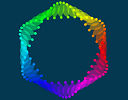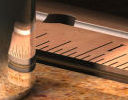IntMath Newsletter: Hexagon, units, primes, Queen
By Murray Bourne, 14 Dec 2018
14 Dec 2018
In this Newsletter:
1. New on IntMath: CSS Animated Hexagon Wave
2. Units
3. Math in the news: Almost prime numbers
4. Brian May - astrophysicist
4. Math movies: Data portraits and fingers
5. Math puzzle: Divisibility
6. Final thought: It's up to us
0. Season's greetings
Here's wishing you all an enjoyable New Year break, no matter your faith. One of the most popular articles on the blog this time of year is:
The Twelve Days of Christmas - How Many Presents?
All the best to you for 2019!
1. New on IntMath
Math Art in Code: CSS Animated Hexagon Wave
 |
Here's an animation made from pure CSS whose wave motion makes it look a bit like a jelly fish. Two triangles intersect to form a stylized hexagon. |
2. Units
Two related stories about units came my way recently.
(a) Calorie or calorie?
It seems there is more than one calorie. Which one should we use?
(b) The kilogram is changing
The kilogram's definition, based on a metal cylinder, had a problem - it was losing mass. Time for a makeover.
 |
See both stories in: |
3. Almost Prime numbers
We know primes have at most 2 factors, 1 and themselves:
2 = 1 × 2
3 = 1 × 3
5 = 1 × 5
7 = 1 × 7
...
Now consider these numbers:
4, 6, 9, 10, 14, 15, ...
Let's look at their prime factors:
4 = 2 × 2
6 = 2 × 3
9 = 3 × 3
10 = 2 × 5
14 = 2 × 7
15 = 3 × 5
Each of them has 2 prime factors. Mathematicians call these "almost prime numbers", and in this case "2-almost prime".
We can also have a set of "3-almost primes", with 3 prime factors each:
8 = 2 × 2 × 2
12 = 2 × 2 × 3
20 = 2 × 2 × 5
28 = 2 × 2 × 7
30 = 2 × 3 × 5
...
What's the point of these "almost primes"? Read more about them and see some of the ways they've been employed to solve some of the most challenging proofs in number theory (which are important in the fields of data encryption) at:
What Is an "Almost Prime" Number?.
4. Brian May - astrophysicist
I recently enjoyed the Queen biopic Bohemian Rhapsody. I was reminded of the educational attainments of the bands' members (degrees in biology, electronics and graphic design), especially that of Brian May's.
May put his PhD studies on hold as the band gained in popularity, and returned to complete it in 2007, submitting it to Imperial College of Science, Technology and Medicine.
His PhD, A Survey of Radial Velocities in the Zodiacal Dust Cloud (PDF, 256pp) uses integral and differential calculus, and not suprisingly, trigonometry.
The zodiacal light, also called the "false dawn" is sunlight reflected by dust particles between the Sun and Earth close to sunrise or sunset.
Brian May was also a mathematics teacher for a time at Stockwell Manor School, Brixton, London.
5. Math Movies
(a) Insightful human portraits made from data
I'm a big fan of data visualizations, and I believe it's a field that will provide a lot of employment in the foreseeable future.
 |
R. Luke DuBois creates fascinating portraits from data which help us to see ourselves in new ways. |
(b) How high can you count on your fingers? (Spoiler: much higher than 10)
6. Math puzzles
The puzzle in the last IntMath Newsletter asked about the sum of numbers in a box. Correct answers with sufficient explanation were submitted by Sue, Nathan, Georgios, Wesen, Douglas, Bandu, Francis and Tomas. Special mention to Eamon, who carefully showed his thinking processes.
New math puzzle: Divisibility
Prove that 2n32n − 1 is divisible by 17 for all positive integral values of n.
You can leave your response here.
7. Final thought - it's up to us
I remember when scientists started talking about the potential for climate change a few decades ago. After repeated warnings, politicians in most countries have let us down, pandering to the "jobs and growth" mantra (which really means "the rich must become super rich, and the rest of us can go to hell"), and allowing the big companies to destroy the water, air, arable land and the forests.
It's going to be up to us - ordinary people - to make a difference. The politicians have had their chance and have failed.
"Do the difficult things while they are easy and do the great things while they are small." [Lao Tzu]
Until next time, enjoy whatever you learn.
See the 21 Comments below.



14 Dec 2018 at 4:55 pm [Comment permalink]
Sir please give some example of area under the curve
14 Dec 2018 at 4:56 pm [Comment permalink]
@Turab: You'll find several examples (after the ads) on IntMath using this search: area under a curve
14 Dec 2018 at 4:57 pm [Comment permalink]
I'm sorry, Dave. I'm afraid I can't do that.
Something messed up. :-(